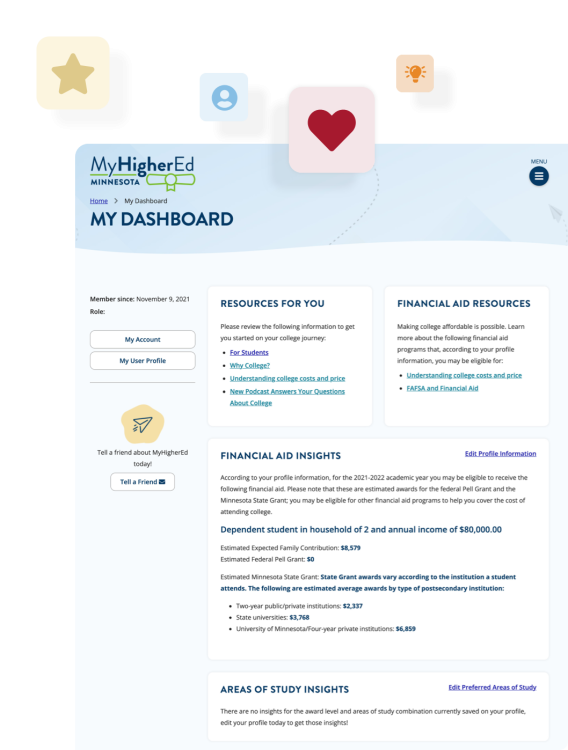You’re the expert when it comes to helping students prepare for college and career, so think of us as a resource to empower you. On this section, you can access printed and online resources for providing information to your students about starting and successfully completing a postsecondary education.
Some of these resources can be directly delivered to your school, so you can hand them to your students as a material they can take home to review later and use when they are ready to start their college search journey. MyHigherEd is a resource for your students as well. Please refer them to MyHigherEd's College Search Tool, the High School Students section, and our publications detailed below.
For a customized experience and personalized information, we recommend students register to MyHigherEd. One of the many perks is saving favorite institutions to their profile and getting personalized insights on financial aid and the careers of their choice.
Prior to starting their college search, your students should determine whether their academic performance and career goals are pointing them more toward a two-year college or a four-year university, and consider other factors such as:
Geographic location
Location, location, location. It’s often associated with buying and selling real estate, but it is just as important when choosing a college.
Minnesota residents can benefit from in-state tuition or the state’s tuition reciprocity program with neighboring states. Some students choose to attend college near their hometown, allowing them to save money by living at home, as well as cut costs on travel, since car rides are usually less expensive than airfare.
You may want to ask your students to consider whether they prefer living in a rural area, city, or some place in between. Small college towns typically have an intimate sense of community, whereas schools in large cities can offer more access to internships with large companies and nonprofits.
School size
Minnesota colleges and universities come in all sizes, from small liberal arts colleges with fewer than 1,000 students to large universities that annually enroll more than 30,000 students.
Large universities can offer a wide variety of majors and courses, housing options and activities. Additionally, large schools typically maintain well-stocked libraries, state-of-the-art research facilities, and nationally recognized sports teams. Notably, introductory classes can be large, which some students find exciting while others find overwhelming.
On the other hand, small schools may not offer as many programs as large universities, but they often provide specialized degrees and lots of hands-on learning opportunities. Small colleges can also mean smaller class sizes, allowing students to easily access individualized support from faculty and staff.
Overall cost
Costs vary from school to school, and there are five main categories of expenses students will need to keep in mind: tuition and fees, room and board, books and supplies, personal expenses, and transportation.
Recommend that students look beyond published tuition prices, since what is listed may not be the actual amount they pay after financial aid and institutional grants. Encourage them to consider colleges that not only offer affordable tuition but also substantial financial aid packages, which may include grants, scholarships, loans and work-study opportunities.
Online programs
More and more institutions are offering programs using the Internet. Online opportunities may provide students with the option of learning in flexible, convenient and personalized formats. The quality of online education can be excellent, providing students with experiences, exercises and assessments that rival the traditional classroom.
However, it’s important for them to be aware that the Internet also offers new ways for educational scams and diploma mills to reach out to people who are looking for genuine education. It is not always easy to identify phony operations from a casual look.
Other Considerations
Finally, choosing college that is a right fit involves many considerations. For many academic quality, location, cost and size are all significant factors. However, there are also other factors students should be aware of and consider, including:
- Campus environment and activities
- Available health and mental health services
- Accommodations for special needs
- Diversity of student population
- Faculty experience and expertise
- Length of time and location of classes
- Graduation statistics for that institution
- Academic reputation and credibility
- Tutoring and academic support services
- Transportation availability and cost
- Campus safety
Introduce Your Students to College and Financial Aid
Many students are unaware of the financial aid available to them to help them pay for college. The first step is always to apply for it and, as you may know, completing the Free Application for Federal Student Aid (FAFSA) is a requirement for most financial aid available. To get an overview of the resources available to the, please review the Paying for College section and consider the following when talking about the FAFSA to your students:
College Planning Series
If your students have questions about the FAFSA, share with them these college planning webinars created specifically for students and families to help them prepare for the college-going process. All sessions are approximately one hour long with a short presentation from financial aid experts, followed by questions from the audience.
Visit the Minnesota Goes to College website to learn more about this series.
MyHigherEd Blog
The MyHigherEd Blog focuses on everything high school students need to know to prepare for college and how their families and trusted advisors can help them along the way.
New posts are published monthly covering topics that most students and families entering higher education are faced with. From financial aid basics to career and educational pathway options, the MyHigherEd Blog is full of tips and resources for students to make their transition into college as smooth as possible.
Top FAFSA Myths... Busted
Our factsheet gives you a summary of the Free Application for Federal Student Aid (FAFSA) online application.

2025-2026 publications
Our publications are free and will be delivered directly to your school.
We Are Here To Help
One of the main duties of the Minnesota Office of Higher Education (OHE) is to provide information to students and their families to help them prepare, pay for, and select their postsecondary education options. Besides providing information on our web pages, OHE publishes each year a set of publications organized by theme as printed resources for teachers, students, and families.
Printed Resources
Minnesota schools can bulk order the following publications at no cost. Some restrictions may apply and items are available on a first-come, first-served basis. If you belong to a partnering organization or have problems logging in, please e-mail us at materials.ohe@state.mn.us.
If you would like to request a single printed copy of one or both of these publications, you may place an order here.
2025-2026 Publications Available
- Choosing a Career Pathway: This publication guides students through their options after high school graduation, including choosing a college or career pathway that is right for them.
- Paying for College: This publication guides students through the cost of attending college and how to make it affordable. It also outlines how to apply for and access the different types of financial aid available, including federal and state grants and scholarships, and federal, state, and private loans.
Also, the U.S. Department of Education provides a wide range of publications and resources for you or the students you serve.
Other online resources
The following external resources may help you answer questions from your students about accessing financial aid, understand the financial aid process, and offer them other resources to create their postsecondary path.
Tools to engage with students and families
- As a complement to MyHigherEd's College Search Tool, you may use this Tuition and Fees Chart with your students to compare Minnesota institutions participating in the Minnesota State Grant Program.
- Provide your students with this online College Planning Workbook to keep them organized during the college and financial aid process.
- Help students and families set up their FSA ID with this easy-to-understand and engaging FSA ID video.
- Suggest your students and their families watch these new, short-form videos about the college application and financial aid process from Minnesota Goes to College.
Financial aid information
- Free Application for Federal Student Aid (FAFSA) |studentaid.gov/h/apply-for-aid/fafsa
Allows students to apply online for student financial aid and check the status of their application. - Federal Student Aid | studentaid.ed.gov
Provides detailed information on pursuing education beyond high school. - FinAid: The Smart Student Guide to Financial Aid | www.finaid.org
Provides links to information on student financial aid. - MN Dream Act Application
Used by Minnesota's undocumented students to apply for state financial aid. - Scholarships Offered by Minnesota Institutions
- Changes That Affect Eligibility
529 College Savings Plans
- Minnesota 529 College Savings Plan | www.mnsaves.org
- Internet Guide to 529 Plans | www.savingforcollege.com
National scholarships
- Information on Scholarship Scams | www.finaid.org/scholarships/scams
- CareerOneStop Scholarship Search | www.careerinfonet.org/scholarshipsearch
- FastWeb Free Scholarship Search | www.fastweb.com
- NCAA Scholarships | www.ncaa.org
- Rotary Scholarships | www.rotary.org/en/our-programs/scholarships
- Scholarship America | scholarshipamerica.org/open_scholarships.php
- Scholarship Experts | www.scholarshipexperts.com
- Scholarships.com | www.scholarships.com
- Tylenol Scholarships | www.college-financial-aid-advice.com/tylenol-scholarship.html
- Union-sponsored Scholarships and Aid | www.unionplus.educationplanner.org
Military family resources
- AMVETS Scholarships | www.amvetsnsf.org/scholarships.html
- Careers in the Military | www.careersinthemilitary.com
- Marine Corps Scholarship Foundation | www.mcsf.org
- Military.com Education Benefits | www.military.com/education-home/
- Military College Help | www.todaysmilitary.com/military-benefits/education-support
- Military Education Service Benefits | www.ohe.state.mn.us/military
- Scholarships for Military Children | www.militaryscholar.org
- Military Transition | www.careeronestop.org/militarytransition/
- My Military Education | www.mymilitaryeducation.org
- U.S. Air Force | www.airforce.com
- U.S. Army | www.goarmy.com
- U.S. Coast Guard | www.gocoastguard.com
- U.S. Navy | www.navy.com
- U.S. Marines | www.marines.com
College admissions test
- ACT, Inc. | www.actstudent.org
- The College Board | www.collegeboard.com/sat
- Test of English as a Foreign Language | www.toefl.org
- General Educational Development (GED) Testing | www.acenet.edu/clll/ged
Minnesota colleges and universities
- Minnesota Private College Council | www.mnprivatecolleges.org
Provides information on 17 of Minnesota's private four-year, liberal arts colleges. - Minnesota State Colleges and Universities | www.minnstate.edu
Provides information on public state colleges and universities in Minnesota. - University of Minnesota | www.umn.edu
Provides information on the University's Twin Cities, Duluth, Crookston, Morris and Rochester campuses. - Minnesota Transfer | www.mntransfer.org
Provides information on how students can transfer credits between Minnesota institutions. - Students United | www.studentsunited.org/scholarships/
Scholarships for students attending one of MinnState's seven state universities.
National college searches
- Accreditation | www.ope.ed.gov/accreditation/
- Campus Crime Statistics, U.S. Dept. of Education | www.ope.ed.gov/security/
- College Answer | www.collegeanswer.com
Provides information on preparing, selecting, applying and financing college as well as college and scholarship searches and a variety of cost calculators. - The College Board | www.collegeboard.org
Provides useful information on financial aid available for students and parents as well as a college search. - College Gold | www.collegegold.com
Provides information on FastWeb's College Gold book and access to interactive tools, calculators, and resources to help you plan and pay for college. - College Navigator | www.collegenavigator.gov
Provides information on colleges, tuition and enrollment demographics through a searchable database. - College View | www.collegeview.com
Provides a college search of schools in the United States and Canada. - Peterson's / Thomson Learning | www.petersons.com
Provides higher education information for parents and students of all ages. - National College Fairs | www.nacacnet.org
Career information
- Apprenticeship Training, U.S. Department of Labor | www.doleta.gov/OA/
- Apprenticeships, Minnesota Department of Labor and Industry | www.dli.mn.gov/workers/be-apprentice
- Explore Health Careers | www.healthcareers.umn.edu
- Occupational Outlook Handbook | www.bls.gov/oco/
Community service
- AmeriCorps | www.americorps.gov
- ServeMinnesota | www.serveminnesota.org
Students of Color: Scholarships for First Generation or Underrepresented Minority Students
- Accounting Scholarships for Minority Students | www.aicpa.org/career/diversityinitiatives/
- Alpha Kappa Alpha Scholarship | www.akaDPO.org | www.akaeaf.org
- American Chemistry Society | www.acs.org/scholars
- American Geological Institute | www.agiweb.org/mpp/
- American Indian College Fund | www.collegefund.org
- American Indian Education Foundation | www.aiefprograms.org
- American Indian Graduate Center | www.aigcs.org
- American Indian Science & Engineering Society | www.aises.org/scholarships
- American Institute of Certified Public Accountants | www.aicpa.org/about/affiliates/aicpafoundation/pages/scholarshipsfellowships.aspx
- American Political Science Association Scholarships for Underrepresented Students | www.apsanet.org
- American Society for Microbiology | www.asm.org/index.php/professionaldevelopment/students
- American Sociological Association Minority Fellowship Program | www.asanet.org/funding/mfp.cfm
- Asian American Journalists Association | www.aaja.org
- Association on American Indian Affairs | www.indian-affairs.org
- AT&T Undergraduate Research Program for Women & Minorities Underrepresented in the Sciences | www.research.att.com/internships?fbid=QGo3t_Zh4oF
- Black Alliance for Educational Options Scholarships | www.baeo.org
- Black Excel Scholarships for Minorities | www.blackexcel.org/25scholarships.htm
- Coca Cola Scholars Foundation | www.coca-colascholarsfoundation.org
- Delta Sigma Theta Sorority Scholarship | dstmsp.org
- Development Fund for Black Students in Science and Technology | www.dfbsstscholarship.org/dfb_sch.html
- Financial Aid for Minority Students | www.finaid.org/otheraid/minority.phtml
- Financial Aid for Native American Students | www.finaid.org/otheraid/natamind.phtml
- Gates Millennium Undergraduate Scholars Program | www.gmsp.org
- Harry S. Truman Scholarship Site | www.truman.gov
- Hispanic Association of Colleges & Universities | www.hacu.net/hacu/Scholarships.asp
- Hispanic College Fund | www.hispanicfund.org
- Hispanic Scholarship Fund | www.hsf.net
- Historically Black College & University Scholarships | www.iesabroad.org/study-abroad/scholarships
- INROADS Internships | www.inroads.org
- International Association of Black Actuaries | www.blackactuaries.org
- Jackie Robinson Scholarship | www.jackierobinson.org
- Links Scholarship | www.linksinc.org
- McNair Scholars Foundation | mcnairscholars.com
- Microsoft Tuition Scholarships | careers.microsoft.com/careers/en/us/internships-scholarships.aspx
- National Action Council for Minorities in Engineering | www.nacme.org/scholarships-overview
- National Association for the Advancement of Colored People | www.naacp.org/page/s/scholarship2
- National Association of Black Journalists | www.nabj.org/?page=SEEDScholarships
- National Association of Hispanic Journalists | nahj.org/about/
- National Society of Black Engineers | www.nsbe.org/programs/scholarships
- Page Education Foundation Grants | www.page-ed.org
- Ron Brown Scholar Program | www.ronbrown.org
- Ronald McDonald House Charities African-American Future Achievers | rmhc.org/what-we-do/
- Rotary International Ambassadorial Scholarships | www.rotary.org
- Scholarship Gateway | www.blackexcel.org/link4.htm
- Thurgood Marshall Scholarship Fund | www.thurgoodmarshallfund.org
- United Negro College Fund | www.uncf.org
- UNCF MERCK Science Initiative | umsi.uncf.org/index.php
- Xerox Scholarships for Students | www.xerox.com/en-us/jobs/minority-scholarships/minority-scholaships-faqs
- University of Minnesota Diversity Scholarships | diversity.umn.edu/scholarships





